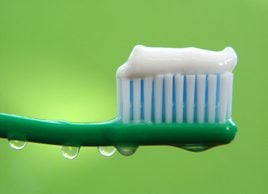What’s lurking in your toothbrush?
Toothbrushes can be home to millions of bacteria. Find out what’s living in your toothbrush and how to keep it clean

Since we use our toothbrushes to clean our teeth every day, most of us assume that they’re clean’but there are a lot of unpleasant things lurking deep down in between the bristles. A plethora of bacteria, germs, fungi and viruses can live quite happily in your toothbrush for months. In fact, scientists have found more than 10 million bacteria living in a single toothbrush.
As these lingering microorganisms multiply, they can compromise your oral health and can actually lead to other health problems in your body. Here are a few of the nasty microorganisms that may be lurking inside your toothbrush.
Streptococcus
The oral cavity is home to many different species of streptococci. Mutans streptococcus is an acid producing bacterium that attacks tooth enamel minerals, which leads to tooth decay and dental caries, otherwise known as cavities.
Beta-hemolytic streptococcus is a bacterium that causes strep throat. Streptococcus sanguis is found in dental plaque, where it modifies the environment to make it less hospitable for other strains of streptococcus. This particular strain of streptococcus can also creep into the bloodstream during dental cleanings, find its way into the heart valves and cause significant damage.
Herpes simplex virus
Oral herpes, also commonly known as cold sores, reveals itself as an infection inside the mouth or on the lips. Herpes simplex is highly contagious and once people are infected with the virus they are infected for life. When first infected, outbreaks occur frequently, but symptoms decrease over time.
Toilet bacteria
If you’re like most Canadians, you store your toothbrush in the bathroom. It makes sense, but have you ever wondered whether your toothbrush is being contaminated from the toilet? Every time you flush, bacteria become airborne and can travel up to five feet away. To keep these bacteria and other nasty toilet germs away from your toothbrush, store your toothbrush as far from the toilet as possible.
Influenza virus
The influenza virus is another nasty bug that can call your toothbrush home. To prevent the spread of cold and flu viruses in your household, make sure you keep your toothbrush isolated from family members’ brushes. A toothbrush holder with individual slots to keep brush heads separated is worth the investment to keep your family healthy. Cross contamination is also the number one reason not to share a toothbrush.
Keeping your toothbrush clean to stay healthy
The best line of defense to stay healthy is to clean your toothbrush and replace it regularly. If you continue using the same old toothbrush, these microorganisms can reinfect your mouth and teeth again and again.
Since most microorganisms are quite cozy living in a damp and dark environment, let your toothbrush dry out between brushing. After each use, shake your toothbrush vigorously under running water and store it in an upright position so it can dry out. Using a separate toothbrush in the morning and another one at night will ensure your toothbrushes are always dry between uses. Rinsing your toothbrush will also help rid the bristles from lingering food debris.
There are all sorts of techniques for cleaning your toothbrush ‘ soaking it in hydrogen peroxide, diluted bleach, or mouthwash is a popular one. But most of these cleaning methods don’t eliminate the buildup of microorganisms in your toothbrush. The best way to prevent the spread of bacteria is to replacing your toothbrush regularly.




